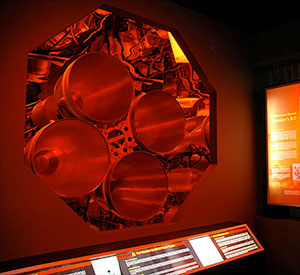June 18, 2005 — Bathed in blue light, a statue of U.S. President John F. Kennedy sits in a rocking chair. Opposite him, red-lit, standing and fist-raised high is a full body bust of Soviet Premier Nikita Khrushchev.
Visitors to the Kansas Cosmosphere and Space Center's Mollett Early Spaceflight Gallery, which opened Saturday (June 18) to the public, pass beneath these two figures as they enter, setting a stage for the Cold War-driven space race they will witness inside.
The contrast between red and blue — U.S. and USSR — is emphasized throughout the new gallery, which presents a multi-media look at the early space exploration efforts of the two adversarial nations. The disparity between color-lit areas is bridged by the proximity of the artifacts to each other. Never before in their respective histories, have the separately-devised space vehicles and spacesuits been so close for comparison.
The Mollett Gallery houses the flown two-person Gemini X spacecraft, a flown Russian Vostok spacecraft similar to that ridden by Yuri Gagarin, and an engineering model of the spacewalk-capable Voskhod, as well as suits used for those spacecraft.
The gallery will be expanded in late 2006 with the return of Virgil "Gus" Grissom's Mercury spacecraft, Liberty Bell 7, to the Cosmosphere. The capsule is presently completing a six-year nationwide museum tour.
"The Mollett Early Spaceflight Gallery is really an anchor for the entire Hall of Space Museum," says Cosmosphere President Jeff Ollenburger. "By focusing on the incredible early days of human space exploration, we see a starting point for everything that is happening in space exploration today."
In addition to the display of the historic vehicles, visitors are taken back in time, to the blockhouse and launch pad at Cape Canaveral, Florida.
Peering through the Blockhouse 5/6 periscope, museum-goers can watch films of rocket launches – witnessing the same images NASA flight controllers saw during the early 1960s. They can then step outside for a launch encounter of a different kind.
Standing within a representation of the Cape's Titan rocket pit, visitors can hear Mission Control chatter and rocket countdown sounds of the Mercury and Gemini launch-day activities. They can then climb up the gantry next to the engines of the 100-foot Titan rocket that propelled Gemini spacecraft into the stratosphere.
Back inside, the exhibit leads viewers to the Hutchinson museum's Apollo exhibit, which includes Odyssey, Apollo 13's command module. The successful U.S. lunar landing program brought the space race to a close.
To formally open the new gallery, the Cosmosphere held a reception on Friday for its sponsors, members and board of directors. Addressing the guests were Roger Launius, Space History Chair at the Smithsonian's National Air and Space Museum; Laura Shepard Churchley, the daughter of the late astronaut Alan Shepard; and Mercury astronaut Scott Carpenter.
"This is a spectacular display of space flight history." said Carpenter. |
|

Bathed in red and blue light, respectively, a bust of Soviet Premier Nikita Khrushchev (at left) faces off with a statue of U.S. President John F. Kennedy at the entrance to the Cosmosphere's new Mollett Early Spaceflight Gallery. (collectSPACE)
 |
